Sales
Sales
This post was originally published in the IL ASCD Winter 2018 journal.
Students come to school with gifts and gaps in their learning and understanding. Two of our important jobs as teachers are to determine what our students’ gifts are and document them while we also learn what their gaps are and plan to help rebuild them. Math games provide a means for teachers and Math coaches to use a variety of methods to learn about students Gifts and Gaps including: indirect and direct observation, one-on-one and small group discussion, written work including journaling, written and oral tests and performance demonstrations. Math games are a non-threatening context, providing a “no anxiety read” of a student’s understanding.
Few people have ever forgotten how to ride a bike once they’ve learned how, and yet, most of us who finished 12th grade have forgotten how to do quadratic equations. Shouldn’t all learning in education be as solid and permanent as “riding a bike”? Those familiar with the writings of brain-based learning researchers such as Eric Jensen, David Sousa, John Arden and others, understand that engaged practice of skills and concepts which involves the use of as many parts of the brain as possible, is one of the most efficient means of moving learning into long term memory.
Executive brief from October 25, 2018 ASCD Smart Brief
Games provide a means for most students to be fully engaged while practicing and mastering concepts and skills in Mathematics (and other subject areas). A game or activity is engaging if the students choose to do it again (ie. no coaxing or rewarding or other means of reinforcement for taking part).
So, how do math games get squeezed into an already packed school day?
Math games should be thought of as an “instead-of”, not an “add-on”. Math games can be used instead of a worksheet, textbook page, or homework. Most math games can be used to help focus practice with a specific state curriculum concept in mind. Well designed games provide practice for integrating several concepts across a range of grade levels.
Engaging math games or activities should be planned for with purpose and as part of a class’ weekly routine, not as a reward for completing less effective work early. That engaged practice, coupled with students verbalizing their understanding (talking the math) and/or writing about their understanding (math journal thought provokers) engage many parts of the brain simultaneously, laying down strong, long-term memory of the concepts.
Math games as part of a class’ weekly routine follows a Monday through Friday cycle. This cycle of engaged math game practice, can be as short as a few days for some units and as long as a few weeks for others. The length of the cycle is determined by the teacher and usually based on the amount of emphasis the state curriculum places on the unit’s concepts.
Introduce the game whole-class, focusing on the game play including the goal, rules of play and management of manipulatives. Students should have enough time to play the new game several times to “work out the kinks” of the game play. During this time, the teacher is circulating making anecdotal observations of the class using 20 foot ‘eyes’, from 5 feet away and side-by-side up close. This closest observation allows the teacher to engage with students one-on-one to modify or differentiate the game so students are challenged, not frustrated. Sometimes, students choose to modify the game themselves to make it more challenging (ie self-differentiation).
As children play they naturally talk. There are ample opportunities for teachers to informally assess a student’s understanding by “playing alongside”, observing their game play or having students demonstrate the game while recording anecdotal information on a class list. (see sample of class list observational data for the math game Primary Super Mush).
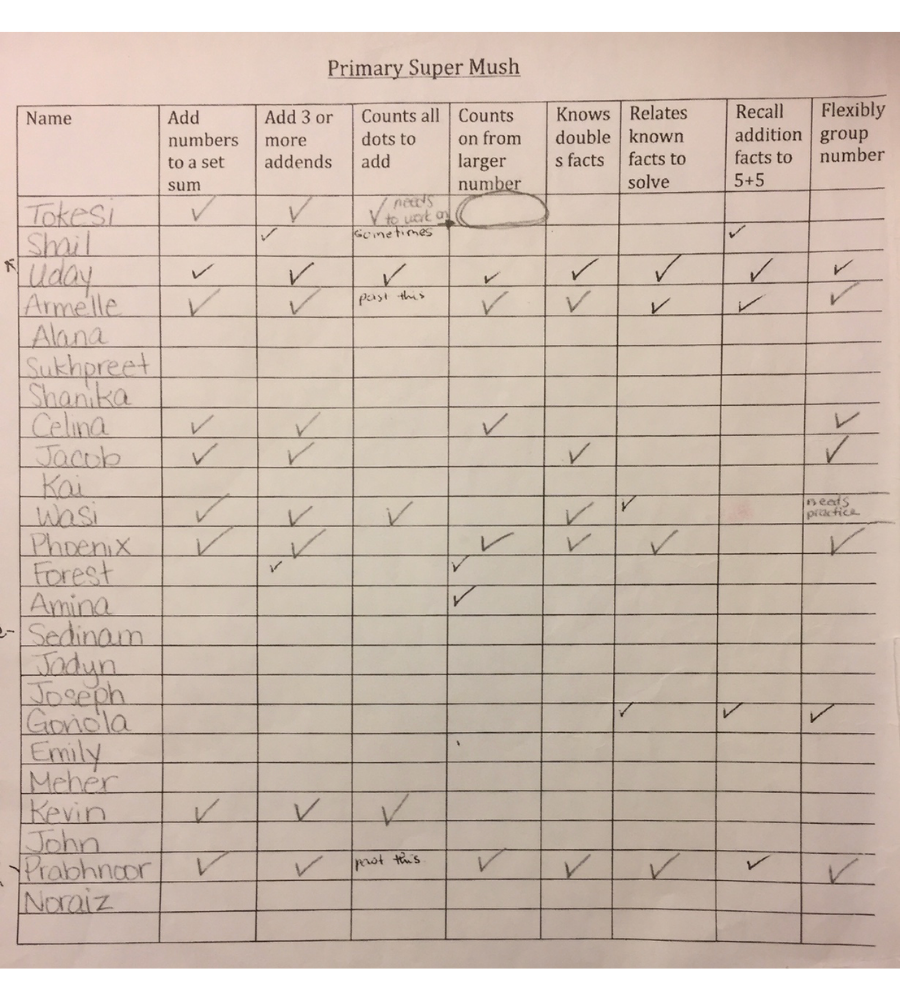
Students play the game again, usually with different partners or groups. Students record their game play either on a recording sheet or on a blank piece of paper where the recording format has been already established by the teacher. (see below for student recording data for math game Salute).
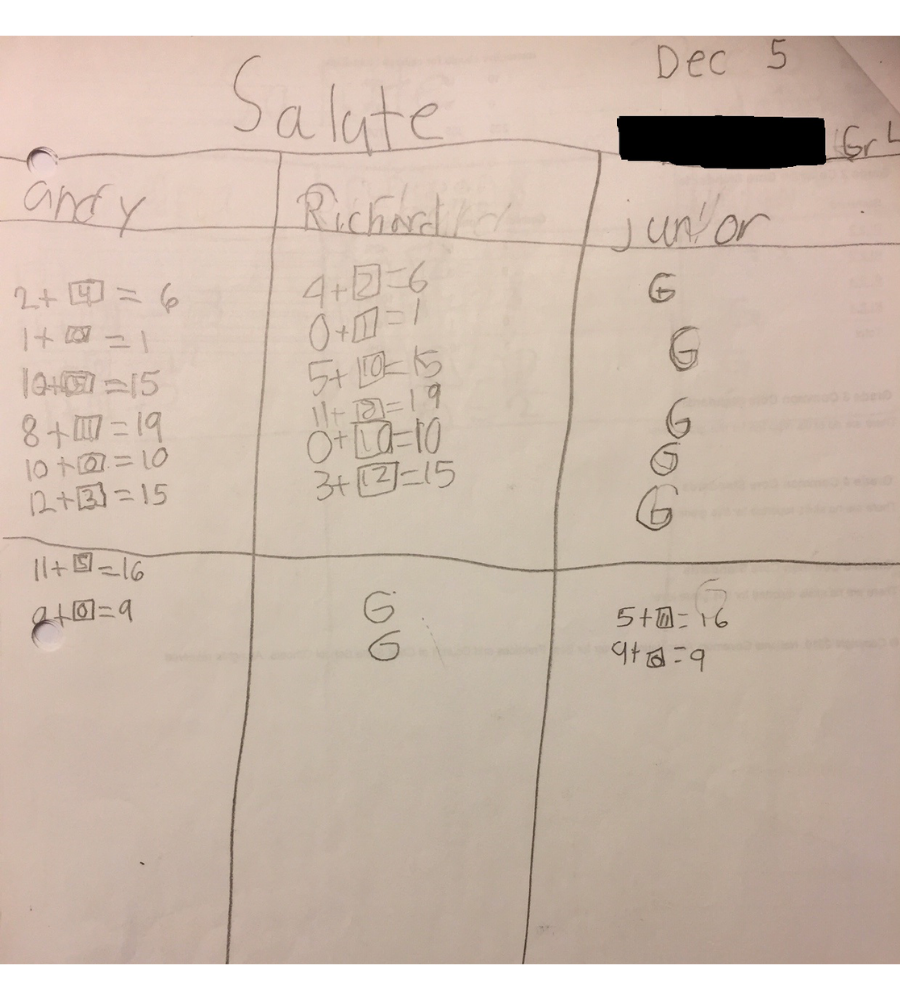
Based on what the teacher observed Monday and learned from reviewing recorded work from Tuesday, small differentiated groups are identified. While the rest of the class is playing with the focus to further refine their strategies and understanding, one of the small groups is pulled by the teacher for intensive pieces of instruction, re-teaching a missed or misunderstood concept with struggling students, or extending concepts for the gifted.
The teacher can dig deeper into the depth of understanding a student has and use focused questioning to help each student consolidate their understanding and their ability to express that understanding. After the teacher is finished working with one small group, that group returns to game play while the teacher works with the next small group. Each student in the class is seen in a small group setting, providing the teacher an opportunity to interact, up close with each student.
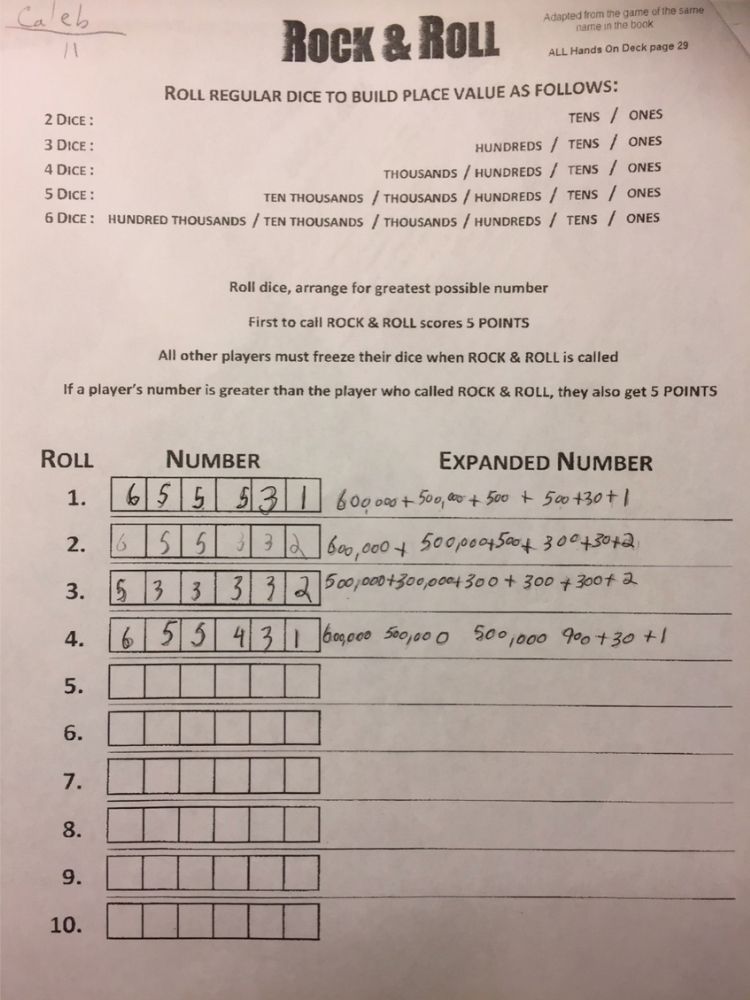
Caleb is a fourth grader whose class was playing a game focused on learning place value into the hundred-thousands. On Monday, the teacher overheard Caleb saying “653,321 > 544,411 because 600,000 >500,000.” The teacher smiled figuring Caleb really knows place value. Looking at Tuesday’s initial written work, the teacher saw Caleb had written his number as “655,243” and again thought Caleb knew his place value. Upon closer review of his written work the teacher noticed Caleb had expanded his number as “600,000 + 500,000 + 500 + 200 + 40 + 3”. Caleb had the “gift” of writing numbers in standard form and the “gap” of incorrectly writing numbers in expanded form. He was grouped together with other similar students for small group work with the teacher on Wednesday.
As the students play, they keep in mind the topic or question (thought provokers) they will be writing about in their journals when game play ends for the day. The teacher provides the topic or thought provoker at the beginning of game play. More thoughtful responses typically occur if the students know the questions in advance so they can focus their game play in ways to help them respond to the journal questions.
Ceili and Jemma were 2nd grade students whose class was learning the concept of place value to 1,000. The game was too easy at that level for the two girls so they modified it to go to 100,000. They also had the opportunity on Thursday to provide written responses to the thought provoker questions.
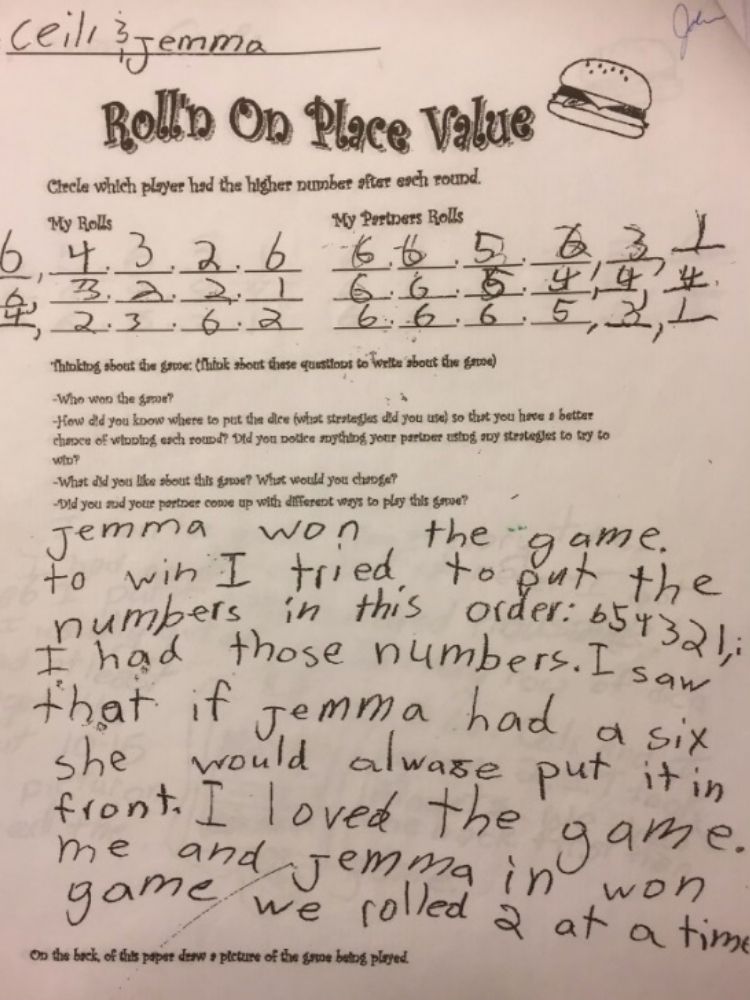
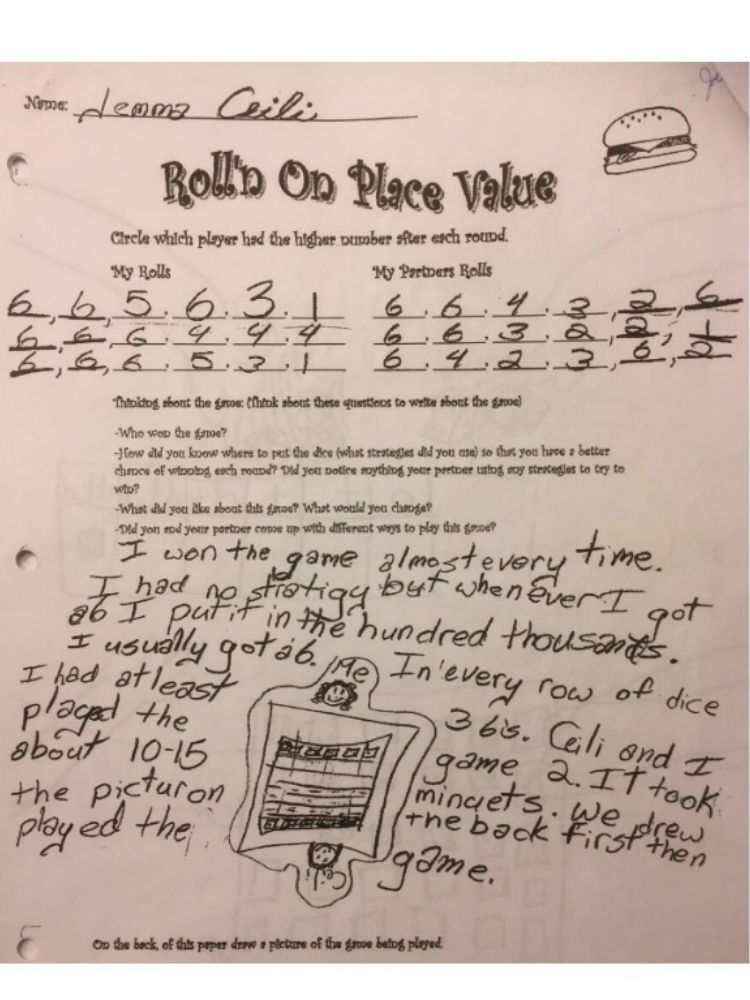
After playing Warp 18, 2nd grade students were asked to write about what they understood the Associative Property of Addition meant. The girl’s response on the left reveals a gap in her understanding while the other girl’s response reveals her strong grasp of the concept.
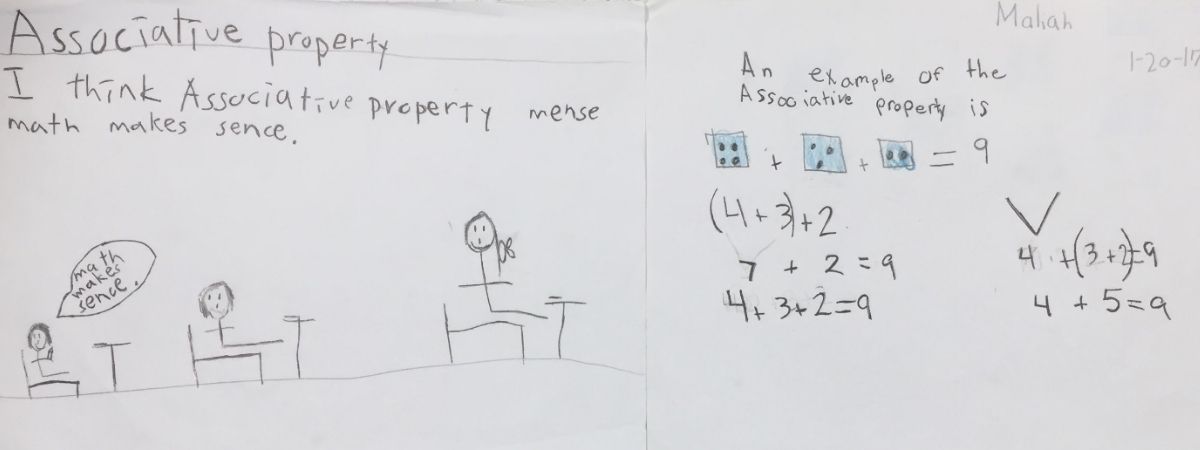
Each student provides a piece of recorded work for their drop file or math journal. There also may be a summative assessment given by the teacher. The assessment strategies described in the Monday to Friday cycle, help us know whether students have an accurate understanding of the concepts while the learning is still in short-term and middle-term memory.
How many of us have said to a student, “How come you don’t know that? You knew it last month!” The fact of the matter is that if students really did know something “last month”, they will know it this month and will know it long into the future (like riding a bike). So, how do we assess whether specific learning is in students’ long-term memory?
Simple, let at least a few days go by (3 or 4 but can be longer) after a unit has been taught and without warning or reminders to study, give an unannounced quiz. If the learning has made it into long-term memory, the students will be able to capably demonstrate it, if not, time to re-teach and replay the game for more practice and insight.
Math games provide a wonderful setting that allow teachers to gather a variety of information about what their students know (“gifts”) and what their students don’t know (“gaps”). They also provide a means for teachers to differentiate their students’ learning so they are challenged and not frustrated. Most importantly, math games provide a means for students to take part in engaged practice leading to solidifying their learning into long-term memory – just like riding a bike
To view our award-winning math games, click here! If you have any questions about our math/literacy games, workshops, or other educational resources, contact us. We offer shipping across North America!
Also, don’t forget to follow us on Facebook, Instagram, and LinkedIn, so you never miss an update!
